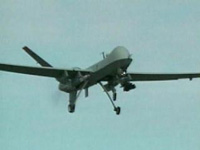print Print...
 (by Gary Robbins, San Diego Union-Tribune) – Southern California might become one of the few areas in the country where industry, business, and government could broadly fly unmanned aerial vehicles over land, an idea that [the ACLU] says…could lead to spying on the public.
(by Gary Robbins, San Diego Union-Tribune) – Southern California might become one of the few areas in the country where industry, business, and government could broadly fly unmanned aerial vehicles over land, an idea that [the ACLU] says…could lead to spying on the public.
A coalition led by the San Diego Military Advisory Council (SDMAC) and the San Diego Regional Economic Development Corporation (EDC) is asking the Federal Aviation Administration to declare a large area of Southern California as a test range for pilotless aircraft. The FAA plans to create six test zones in the U.S. in an effort to integrate drones into domestic airspace.
The San Diego group says in an announcement that it wants a test range that would extend from “Naval Air Station China Lake and Edwards Air Force Base west to the ocean and south to the Mexican border and east to the Arizona border. The range is geographically diverse and includes airspace over mountains, high and low desert, an international border region and the ocean.”
The application is meant to enrich the drone industry in San Diego County, which is already home to the country’s two largest unmanned aerial vehicle (UAV) makers, Northrop Grumman in Rancho Bernardo and General Atomics Aeronautical Systems in Poway. Northrop is known worldwide for its Global Hawk family of drones. GAAS builds Predator drones, which have been used in such places as Iraq and Afghanistan.
A study by the National University System estimates that 7,135 people were directly or indirectly employed by the UAV industry in San Diego County in 2011. They were assigned to projects that brought in $1.3 billion, a figure that has roughly doubled since 2008. It’s one of the few areas of the local defense industry that’s growing. Northrop recently announced that it will close drone operations in two other states and consolidate its UAV program in Rancho Bernardo, adding about 300 jobs to the workforce.
“We think that more jobs can be added,” said Larry Blumberg, executive director of SDMAC, a booster group. “There is going to be an increased use of commercial systems, which is why the FAA is working to integrate them into the national air space.
San Diego faces tough competition, and some opposition, in getting the region declared a test range. Almost 40 applications have or are being filed by various groups, including the state of Nevada, which boasts of wide open spaces where drones could fly.
The ACLU issued a policy statement [in March] that says, in part, “Unmanned aircraft carrying cameras raise the prospect of a significant new avenue for the surveillance of American life … The technology is quickly becoming cheaper and more powerful, interest in deploying drones among police departments in increasing, and our privacy laws are not strong enough to ensure that the new technology will be used responsibly and consistently with constitutional values.
“We need a system of rules to ensure that Americans can enjoy the benefits of this technology without bringing our country a large step closer to a ‘surveillance society. ‘ ”
Published at utsandiego.com on March 22, 2013. © Copyright 2013 The San Diego Union-Tribune. Reprinted here for educational purposes only. May not be reproduced on other websites without permission from UTSanDiego.com.
Questions
1. What is the FAA planning on creating in the near future?
2. Why is the ACLU opposed to San Diego (or any area) becoming a “drone zone”?
3. Why do the San Diego Military Advisory Council and Economic Development Corp. want the San Diego area to be designated as one of the FAA’s “drone zones”? Why do they say their area is a good test range?
4. What economic benefits would San Diego receive if designated a drone zone?
5. Besides opposition to the program, what might prevent the FAA from choosing San Diego as one of its drone zones?
6. Would you want your town/city to be designated a drone zone? Why or why not?
Daily “Answers” emails are provided for Daily News Articles, Tuesday’s World Events and Friday’s News Quiz.



